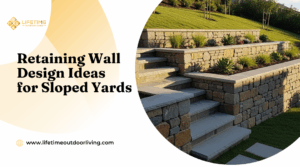Designing the ultimate outdoor kitchen with a built-in BBQ island requires careful planning and quality craftsmanship. The key to creating a functional and stylish outdoor kitchen lies in combining durable materials, an efficient layout, and seamless integration with the surrounding landscape. Lifetime Outdoor Living, a paving contractor based in Laguna Beach, California, specializes in outdoor remodeling that enhances both beauty and usability.
By focusing on custom design and expert installation, Lifetime Outdoor Living helps homeowners create outdoor kitchens that become the centerpiece of backyard entertaining. Their approach ensures the BBQ island fits perfectly within the overall space, balancing convenience, aesthetics, and durability.
Choosing the right materials, considering workflow, and including essential elements like storage and seating are critical steps in the design process. Lifetime Outdoor Living’s experience with pavers and hardscaping adds value by providing strong foundations and attractive finishes that withstand Orange County’s climate.
Why Invest in an Outdoor Kitchen with a Built-In BBQ Island?
An outdoor kitchen with a built-in BBQ island enhances social gatherings, adds value to a home, and improves the flow between indoor and outdoor living spaces. It combines practical features that suit Laguna Beach’s climate with design elements that benefit daily living and long-term investment.
Enhancing Entertainment and Family Gatherings
A built-in BBQ island acts as a natural focal point for outdoor events. It allows cooks to prepare meals while staying engaged with guests, avoiding the isolation common with indoor kitchens. Features like ample counter space, storage, and integrated appliances streamline food prep and service.

The design encourages longer, more comfortable gatherings, with seating options and shelter from sun or wind. It also supports diverse cooking styles beyond grilling, such as smoking or pizza ovens. This flexibility suits different tastes and occasions, making outdoor entertaining more enjoyable and convenient.
Boosting Property Value in Coastal California
Outdoor kitchens increase a home’s market appeal, particularly in regions like Laguna Beach where outdoor living is highly desirable. A well-designed built-in BBQ island signals quality and thoughtful landscaping, which attracts buyers interested in lifestyle amenities.
Adding durable materials like stone countertops and stainless steel appliances ensures low maintenance in coastal conditions. These investments can yield returns through higher resale prices and faster sales. Real estate surveys indicate outdoor living spaces often rank among top homeowner priorities in this market.
Creating a Seamless Indoor-Outdoor Living Experience
Integrating an outdoor kitchen with adjacent indoor areas creates a sense of flow that expands usable living space. Sliding doors or large windows connecting to the BBQ island area maximize natural light and air circulation.
This design promotes comfort and accessibility, allowing easy movement between cooking, dining, and relaxation zones. It leverages Laguna Beach’s mild climate, encouraging frequent use throughout the year. Functional layouts help to unify style and practicality across both environments.
Planning Your Outdoor Kitchen: What to Consider First
Designing an outdoor kitchen requires careful thought about the available space, how it will be used, and the budget. Each factor directly affects the overall layout, features, and timeline for completion.
Space and Layout: Assessing Your Backyard’s Potential
The first step is measuring the backyard area to determine where the built-in BBQ island and other elements will fit. Consider existing structures, property lines, and access points to avoid overcrowding or awkward placement.
Sun exposure and wind direction also matter. Positioning the kitchen for comfort and usability during peak times enhances the experience. Pathways should allow easy flow between the indoor kitchen and outdoor space.
Incorporate necessary utilities early. Planning gas, water, and electrical connections at this stage prevents costly adjustments later. A functional layout balances cooking, prep, storage, and seating zones efficiently.
Purpose and Usage: Weekend Grilling vs. Full Outdoor Dining
Clarifying how the kitchen will be used shapes the design. For casual weekend grilling, a simple BBQ island with limited prep space may suffice.
If the goal is full outdoor dining and entertaining, a more comprehensive setup with multiple cooking appliances, refrigeration, and ample seating is needed. This impacts the size and complexity of the island and countertop areas.
Frequency of use also guides decisions on durable materials and weather resistance. The design should align with lifestyle habits to ensure practicality and satisfaction.
Setting a Realistic Budget and Timeline
A clear budget outlines what materials, appliances, and labor costs the project can include. It prevents overspending and guides choices between premium and standard options.
Discussing the timeline with contractors helps manage expectations. Site preparation, foundation work, and installation phases each have specific durations, influenced by weather and permits.
Allow contingency funds for unexpected delays or upgrades. Transparent budgeting and scheduling help avoid frustration during construction and deliver the project on time.
Must-Have Features for the Ultimate BBQ Island Setup
A well-planned BBQ island balances function and durability. It includes equipment and materials that hold up under outdoor conditions while offering convenience and efficient workflow.
High-Quality Built-In Grill: Gas, Charcoal, or Hybrid?
Choosing the right built-in grill depends on cooking style and maintenance preferences. Gas grills offer quick startup, precise temperature control, and clean operation, making them ideal for most users. Charcoal grills provide a smoky flavor but require more effort to light and clean. Hybrid grills combine both fuel types, offering versatility but often at a higher cost and complexity.
Durability must be considered. Stainless steel construction resists rust and heat damage. Look for frameless burners and easy-to-access grease traps. Size and BTU output should match typical cooking volume to avoid energy waste or crowding.
Countertops and Prep Space: Materials That Withstand the Elements
Countertops must resist weathering, heat, and stains. Granite and concrete are popular for their durability and heat resistance. They remain cool to the touch and can handle hot pans without damage.

Other options include stainless steel, which is easy to clean and withstands moisture, but can dent or scratch. Porcelain slabs are less common outdoors but offer high durability and low maintenance. The prep space should be ample, ideally 3 to 4 feet wide, to allow multiple users and food preparation simultaneously.
Built-In Storage: Cabinets, Drawers, and Trash Solutions
Storage keeps the outdoor kitchen organized and protects tools from weather. Marine-grade stainless steel cabinets and drawers resist corrosion and moisture. Lockable doors add security for tools and supplies.
Trash solutions should be integrated with easy access and ventilation to prevent odors. Motion-sensor or foot-pedal bins help maintain hygiene. Storage areas also benefit from adjustable shelving to accommodate various items, from utensils to propane tanks.
Sink and Plumbing Considerations
Adding a sink requires proper plumbing that can withstand outdoor conditions. Stainless steel sinks paired with weather-resistant faucets reduce corrosion risk. Consider frost-free or insulated plumbing lines to prevent freezing in colder months.
A practical sink location near prep areas improves workflow. Installing a hot and cold water supply adds convenience. To conserve water, include a faucet with a high-efficiency aerator or hand-operated sprayer for cleaning.
Enhancing Functionality with Outdoor Kitchen Add-Ons
Adding specific features can improve convenience, efficiency, and comfort in an outdoor kitchen. These elements make cooking and entertaining smoother while complementing the core BBQ island setup.
Refrigeration: Mini-Fridges, Beverage Centers, and Ice Makers
Mini-fridges keep food and drinks cold and within easy reach, reducing trips indoors. Beverage centers are designed specifically for bottles and cans, often with glass doors for display. Ice makers ensure a steady supply for drinks and food preservation.
Choosing the right size and style depends on available space and usage frequency. Energy efficiency and weatherproofing are important for outdoor durability. Installing refrigeration close to the cooking area maximizes convenience.
Side Burners, Smokers, and Pizza Ovens
Side burners expand cooking options, providing space for sauces, sides, or frying. Smokers add slow-cooking versatility, allowing for smoked meats and complex flavors. Pizza ovens offer high heat and quick cooking, enhancing menu variety.
Placement should balance accessibility and safety. Quality materials resist heat and weather conditions. Each option increases the kitchen’s functionality without cluttering the main grill space.
Integrated Lighting and Electrical Outlets
Proper lighting improves visibility while cooking after dark, making outdoor kitchens usable at any hour. LED fixtures mounted under counters or overhead provide focused, energy-efficient illumination.
Electrical outlets support appliances, phone charging, and additional lighting. Weather-resistant, ground-fault circuit interrupter (GFCI) outlets ensure safety outdoors. Strategically placed outlets prevent cords from interfering with work areas.
Design Aesthetics That Match Your Outdoor Space
The design of an outdoor kitchen should integrate seamlessly with the existing environment. Material selection, color coordination, and the relationship with surrounding hardscape and landscape elements all influence a cohesive appearance.
Choosing Materials: Stone, Stucco, Brick, or Tile
Material choice impacts durability and style. Stone provides a natural, rugged look that fits well in coastal or rustic settings. Stucco offers a smooth, modern finish common in California homes and handles weather well.
Brick gives a classic, timeless appeal and pairs nicely with traditional architecture. Tile allows for customization with patterns or colors, ideal for adding distinct character. Consider climate resilience and maintenance in selecting materials to ensure long-term value.
Color Schemes That Complement Your Home Exterior
Colors should relate directly to the house exterior or outdoor features. Earth tones such as taupe, beige, and gray blend naturally with many landscapes. White or light colors can brighten an area but require more upkeep.
Bold hues like navy or forest green work best as accents rather than primary colors. Using complementary or analogous palettes enhances visual flow. Consistency in color creates a harmonious connection between the outdoor kitchen and home exterior.
Coordinating with Pavers, Hardscape, and Landscape Design
The outdoor kitchen must fit into the larger outdoor layout. Match or complement paver styles and colors to unify patio and kitchen areas. For example, smooth concrete pavers pair well with contemporary designs, while irregular flagstone suits natural themes.
Incorporate similar textures or patterns found in landscaping elements like garden beds or stone pathways. Integration with lighting fixtures and furniture styles further refines the overall space. Proper coordination maximizes both function and aesthetic appeal.
Weather-Proofing and Long-Term Durability
A well-designed outdoor kitchen must resist rust, withstand weather exposure, and maintain functionality over time. Attention to materials, protective structures, and proper water management ensures longevity and optimal use throughout the year.
Selecting Rust-Resistant Fixtures and Appliances
Choosing fixtures and appliances made from rust-resistant materials is crucial. Stainless steel with a 304 or 316 grade is preferred for grills, sinks, and hardware due to its corrosion resistance in coastal climates like Laguna Beach. Aluminum and powder-coated steel also offer protection but may require more maintenance.
Regularly inspecting seals and finishes helps prevent moisture intrusion. Avoid metals like iron or untreated steel, which corrode quickly. For faucets and drawer pulls, brass or marine-grade stainless steel extends service life.
Lifetime Outdoor Living recommends investing in sealed electrical components and weather-rated fittings to further reduce rust risks and ensure reliable operation under constant exposure.
Covers, Pergolas, and Shade Structures for Year-Round Use
Permanent or retractable covers protect appliances and surfaces from sun, rain, and debris. Durable materials like polycarbonate roofing or weather-resistant fabric provide effective shelter without reducing airflow.
Pergolas add shade and can be fitted with waterproof canopies to shield against rain. They also help regulate temperature around the cooking area, reducing heat damage.
Adding adjustable shades increases flexibility during different seasons and times of day. Structures should be anchored securely to resist wind and installed to allow easy access for cleaning and maintenance.
Drainage and Ventilation Best Practices
Proper drainage prevents water pooling that can damage cabinetry and appliances. Installing slight slopes on countertops and paving directs runoff away from the kitchen area. Incorporating drain channels or French drains beneath paving surfaces is advisable.
Ventilation reduces heat buildup and moisture accumulation inside BBQ islands and storage areas. Vent grilles or louvered panels promote airflow but must be covered with mesh to block insects.
Combining good drainage with effective ventilation extends the life of the outdoor kitchen components and maintains a comfortable cooking environment in any weather.
Outdoor Kitchen Layout Styles and Flow
Choosing the right layout and flow is essential for efficiency and comfort in an outdoor kitchen. Attention to workspace arrangement, movement between stations, and guest seating enhances usability and social interaction.
Linear, L-Shaped, U-Shaped, or Island Layouts
Linear layouts place appliances and prep areas in a single line, ideal for narrow spaces. They maximize wall space but can limit movement.
L-shaped layouts use two adjacent walls or counters forming a right angle. They create a natural corner workspace and separate cooking from prep zones effectively.
U-shaped layouts surround the cook on three sides, offering ample counter space and storage. This design supports multiple workflows but requires more space.
Island layouts feature a central cooking and prep area accessible from all sides. This encourages interaction and is flexible for various cooking styles.
Creating a Natural Workflow from Prep to Plate
A logical sequence improves cooking efficiency. Ideally, it starts with refrigeration, then prep space, cooking appliances, and finishes with serving or plating areas.

Clear pathways minimize unnecessary steps. Grouping related tasks together, such as prep and grill placement, reduces cross-traffic and congestion.
Including a sink near prep zones supports cleanup and prep simultaneously. Accessibility to utensils and condiments should be considered in layout planning.
Seating Arrangements and Guest Interaction
Strategically placed seating promotes conversation and comfort. Bar stools along an island encourage direct interaction with the cook.
Separate dining tables suit larger groups and create a defined eating area. Consider weather protection and lighting for outdoor seating comfort.
Seating should not block walkways. It must allow easy movement around cooking and serving areas for both hosts and guests.
Building with Lifetime Outdoor Living: Why It Matters
Lifetime Outdoor Living designs and builds outdoor kitchens that respond directly to Laguna Beach’s unique conditions. Their approach ensures durability, aesthetics, and functional integration tailored to every client’s property.
Local Expertise in Laguna Beach Terrain and Climate
Lifetime Outdoor Living understands Laguna Beach’s coastal environment and its challenges. Their experience with salty air, intense sun, and occasional marine moisture helps them choose materials and construction methods that resist corrosion and fading.
They prioritize drainage solutions and foundation work that suit the area’s sandy soils and slopes. This local knowledge minimizes maintenance needs and extends the lifespan of outdoor kitchen installations.
Custom Design + High-End Craftsmanship
Each outdoor kitchen is tailored to fit the homeowner’s cooking style and entertaining needs. Lifetime Outdoor Living offers a range of premium materials, from natural stone countertops to stainless steel appliances.
Their craftsmen focus on clean lines, precise joins, and professional finishes. This attention to detail ensures the BBQ island looks elegant while standing up to daily use and weather exposure.
Seamless Integration with Existing Landscape and Hardscape
Lifetime Outdoor Living works closely with paving contractors and landscape designers to blend the outdoor kitchen naturally into the property. They consider existing patios, pathways, and plantings to maintain visual flow.
Their installations complement the existing hardscape using color-matched materials and consistent styles. This approach avoids abrupt transitions and creates a coherent outdoor living space.




